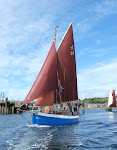Cast off from the pontoon at Brightlingsea at 0415. There was enough light to see as we made our way out of the harbour and into the Crouch. The wind was pretty much on the nose, so we got the main up.,then cut across Colne Bar as soon as it felt safe. We were just on high tide, so there was plenty of water.

Out came the jib, just as reluctantly as yesterday, and we had a lovely broad reach up to Walton Pier in record time (for us)! I saw a couple of seals, which was good. The wind was going a bit light, so we put the motor on for a bit, but soon turned it off, it was just so nice a day for sailing!
We crossed the shipping lane out of Harwich quite a way off shore, near the Cork Sands, then furled the jib and went for the reaching sail which we carried all the way to Aldeborough Ridge. The tide had turned against us by this time, and the main kept lifting in the swell even though the sails were full. I was feeling the early morning, and felt a bit grumpy, but after a cup of tea and a caramel wafer I was glad to be sailing again. When we tried to go on to a slightly different course at the end of the Ridge the reaching sail kept collapsing, so Julian put it away, and we got the jib out again.
We were slowed to a crawl, (the GPS predicted gone midnight at Lowestoft) so the engine went on, and Julian helmed for the next two hours while I had a bit of a sleep.
I took the helm as we got close to Southwold. The tide was with us again and the wind came up, so I turned the engine off. I could see the flash of the Southwold Lighthouse. Its interesting how tall its tower looks from out at sea, although it looks tiny from the town.
We had an unexpected visitor here, a small but fearless bird that decided
Robinetta made an acceptable resting place. It liked the coiled ropes by the cabin, but stopped first, and last, on my head to get a good look round. If anyone recognises what it is, please comment as I don't have a clue!

After our visitor the wind kept rising, and I found it quite difficult to steer. We could have changed down the jibs, but that would have meant reefing to balance the boat, so Julian rigged me a pulley like he did last year on the way home from Cowes, and it worked a treat. We were sailing along at over 7 knots, and the GPS forecast of when we would reach Lowestoft came down to 1830.
We were going fast on a very broad reach as we passed the South Holm cardinal, and I was afraid we would gybe if I tried to change course, or go onto the sands if I didn't. We hauled the main right in, and put the engine on.
Robinetta became more controllable on engine and foresails, but I could tell that there would be a problem if we left the main up, so Julian got it down. I did offer to go head to wind to help, but it is possible to lower the main on a gaffer on a run, so we did.
There might be problems getting the jib out, but the Wickham Martin still works for furling, so the jib rolled away and we turned towards the harbour entrance on the engine and stay sail. The tide had been helping us beautifully up to that point, but I knew it would be interesting getting back uptide and into the harbour. There were a lot of short steep seas, and
Robinetta rolled all over the place. We also had to ferry glide across the tide to make the entrance. Motoring sideways up to the harbour entrance was not elegant, but it worked!
I dropped the staysail when we were safely into the outer harbour, then Julian called up the Royal Norfolk and Suffolk Yacht Club and we went onto their visitors pontoon. We were moored up by 1850, and I realised I had been on the helm for three hours. Time flies (like birds!) when you're having fun!

 There were a lot of
shipping movements, and once we were ready to go we had to wait for
a tug to come through into the fish dock, then hurry to clear the
dock area as a large ship came out from the Royal Dock right next to
the Fish Dock. There were more big ships waiting to enter the Royal
Dock so we stayed in shallow water on the Lincolnshire side for a
while.
There were a lot of
shipping movements, and once we were ready to go we had to wait for
a tug to come through into the fish dock, then hurry to clear the
dock area as a large ship came out from the Royal Dock right next to
the Fish Dock. There were more big ships waiting to enter the Royal
Dock so we stayed in shallow water on the Lincolnshire side for a
while.
































